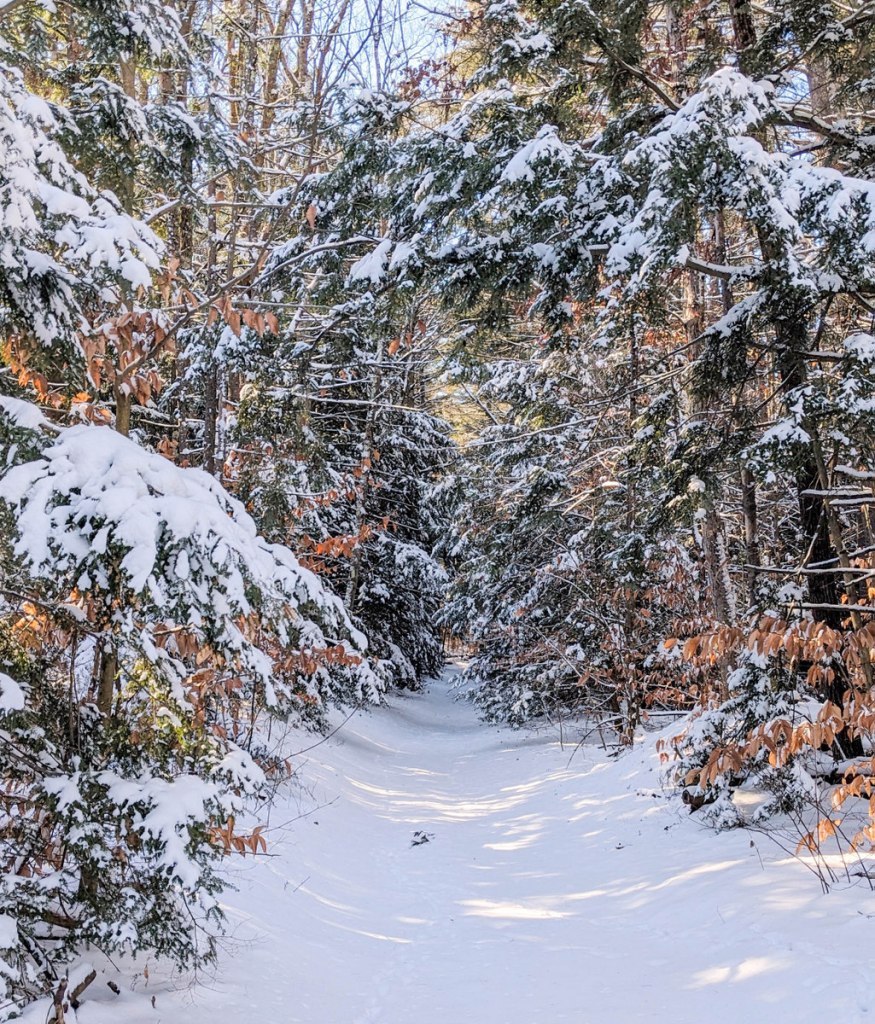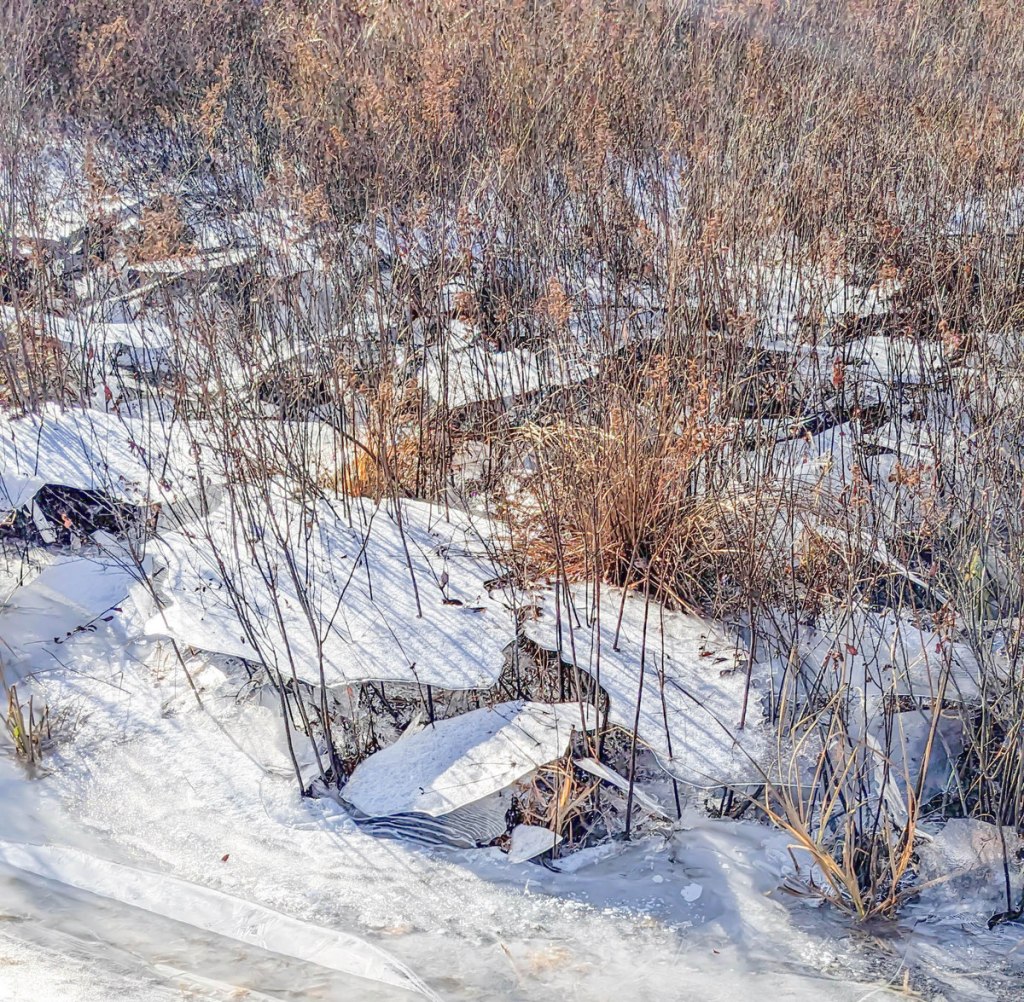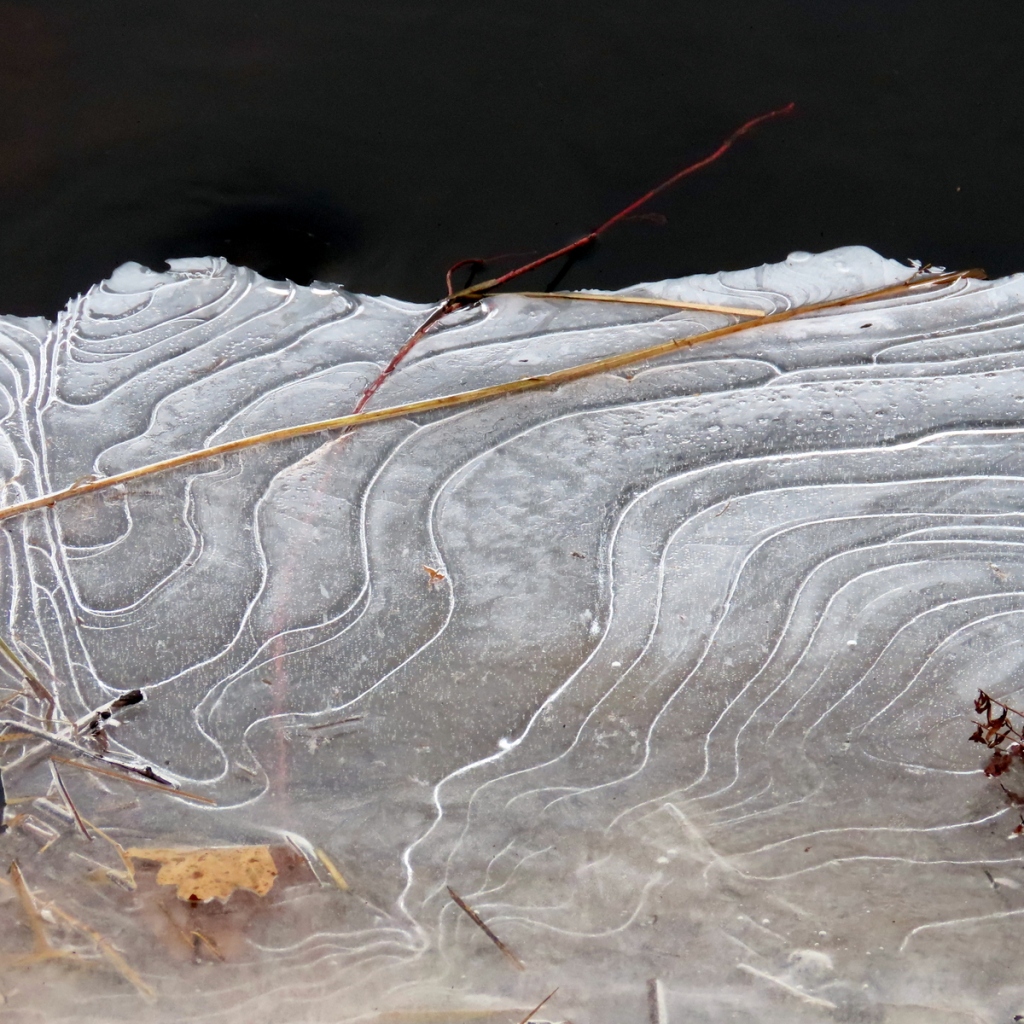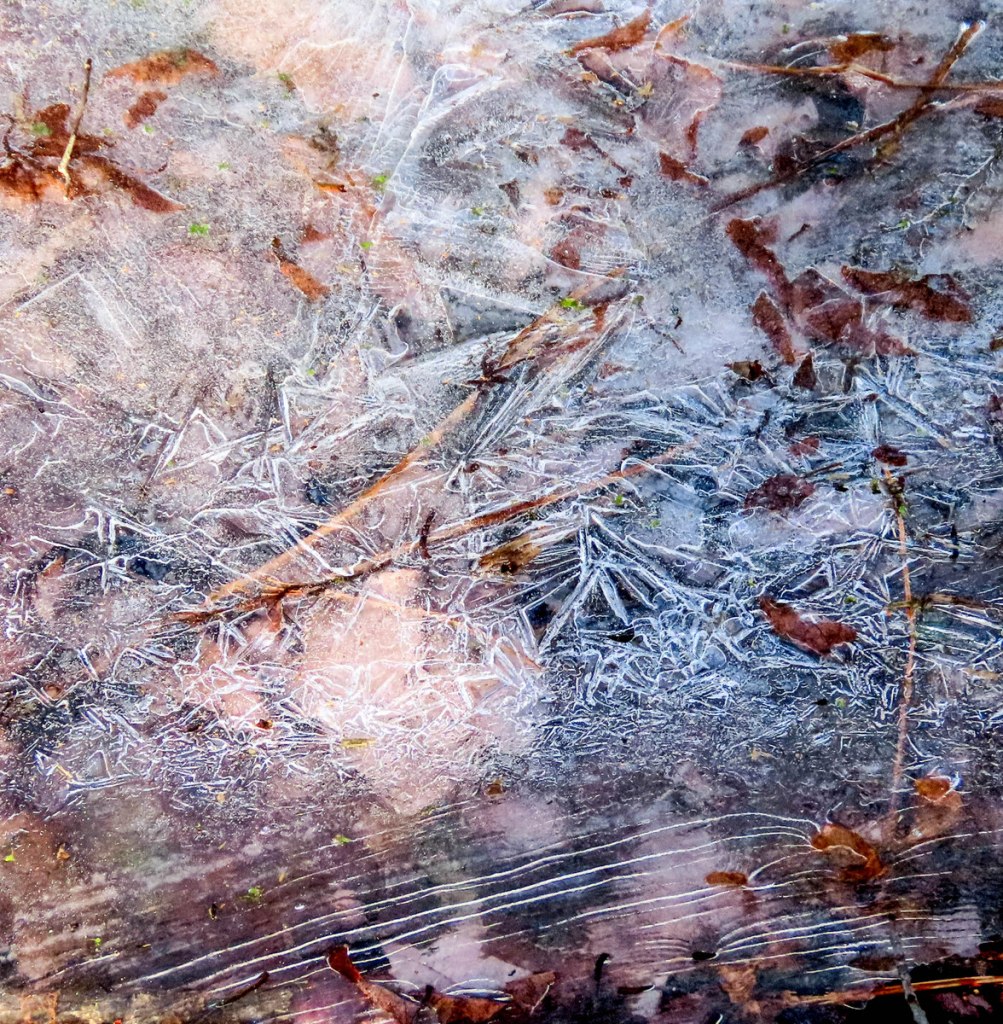
Hello again everyone. I hope you all had a Merry Christmas and are having a Happy New Year. I thought I’d better do a post and show you the first real snow of the year, which fell on January 7th. I say it’s the first real snow because we’ve had a dusting and a nuisance storm of about half an inch, but this one was a plowable 4-5 inches. This old road is one of my favorite winter scenes so I had to get out and get a photo of it before the wind blew all the snow off the trees. I thought it was very beautiful with all the colors of the oak and beech leaves mingling with the white of the snow in the morning sunshine.

This shot of a dandelion in bloom was taken by cellphone just 7 days before that first snowy photo, on December 31st. The two photos illustrate the up and down, freeze and thaw cycle we seem to be stuck in at present. The snowy scenes didn’t last long thanks to 48 degree temps and pouring rain just 2 days after it fell. That’s the way the last two or three winters have gone. The dandelion is the only flower I’ve seen bloom in all 12 months of the year.

This just about says it all. If you can picture that little raindrop freezing at night and then thawing when the sun hits it in the morning, that seems to be the latest version of winter in New Hampshire. I read that the average winter temperature is now 3.5 degrees warmer than it was ten years ago. I’m not here to talk about right or wrong, good or bad, or this or that; I’m just reporting what is.

We had enough rain to make the river flood and when that happens thankfully much of the water ends up in unused fields like this one. I like to get out after the flood waters freeze because that’s when you can see and hear some amazing things.

When the ice begins to shatter some ice plates can be bigger than a car tire. When they’re supported by shrubs as they were here you can tell how deep the water was when it froze over. In this instance I guessed it had been about 18 inches deep. Standing here watching and hearing them break up in the warm sunshine was amazing.

The ground isn’t frozen yet so the water quickly drains away, leaving the ice high and dry. When the sun hits this ice that is left just floating in space the ice begins to shatter and when it does it sings, sometimes tinkling, sometimes crashing. Sometimes you hear loud snapping sounds made by ice cracking under pressure, and it can be startling.

That’s just what happened shortly after this killdeer landed beside me while I was standing and listening to the ice sing. All of the sudden there was a loud snap and crash when ice caved in and this bird flew straight up into the sky like it was a jet airplane. I had to laugh because I had jumped at the sound of the loud noise as well. This is not a great shot of this bird because I was surprised to see it just feet away and of course I didn’t have my camera turned on so there was a lot of fumbling going on.
Killdeer are in the plover family and aren’t seen that often, at least not by me. Its name comes from its “shrill, two-syllable call,” which someone apparently thought sounded like “kill deer.” Where people get these ideas from, I don’t know. Females lay their eggs directly on the ground, often in gravel. I’ve read that the eggs don’t get eaten by predators because they look like stones. If a predator gets too close to the nest the female will flutter on the ground pretending to have a broken wing, and lure the predator away. It’s a very clever bird.

Of course ice can be beautiful, so I always take a closer look. I love the wave like patterns that are often found frozen in ice but I’ve never been able to figure out how it happens. I’m sure wind must have a lot to do with it.

This was a large piece of ice on the shore of a small pond. I thought it was beautiful, almost like a sand dune in shape, and its color reminded me of puddle ice. Years ago I read that ice that is white like this has more oxygen in it; millions of tiny bubbles color it white. It is almost always very thin and it tinkles like the very thin glass of a fluorescent tube when it breaks.

Endlessly fascinating and beautiful, that’s what ice is to me.

I’ve seen this pond freeze over and then thaw again several times since mid-December. It always has interesting frozen bubbles on its surface.

I’ve seen a few examples of “winter fungi” including this one that I saw peeking out from under the bark on a log in a December. I haven’t bothered identifying it.

I’ve also seen lots of color so far in these colder months. This crowded parchment fungus was at its best on a rainy day and it glowed like a beacon so I could see it long before I reached it. You find this common fungus growing on limbs that have fallen from nearby trees. I always wonder how fungal spores get so high into the crown of a tree. Wind I suppose, or maybe they stick to the feet of birds.

Speaking of birds, I’m seeing lots of bluebirds this year. Years ago I saw my first bluebird sitting on a post and rail fence, and then I didn’t see another one for probably 30 years. That’s because I wasn’t looking in the right places. They like wide open spaces like old fields and wetlands, which is just where I saw this one. They’re a good reason to come out of the forest every now and then because they’re beautiful, and they’re also my favorite color. In warmer months they eat insects and in cold weather seeds and berries. This one heard me coming from a few yards away, just about when I saw him, and turned his head to see what I was up to. Often when I see something so beautiful I forget I have a camera, but on this day I had sense enough to get a shot. I love the curled markings on its feathers. They made me realize that I had never seen a bluebird’s back.

There are lots of dogwoods, many different viburnums, highbush cranberry, and other native fruit bearing shrubs here in the wetlands, so I’m sure that has something to do with the large bluebird population.

Bluebirds like to nest in hollow trees but I knew I wouldn’t find one in this hole, because it was in a fallen log.

Still, I had to take a closer look to see if anyone was home. I didn’t see anyone or hear any little feet rustling but I was happy just to see the beautiful wood grain, so it didn’t matter.

I saw this wooly bear caterpillar sauntering down a road on January 10th. These caterpillars produce their own antifreeze and can freeze solid in winter but once the temperatures rise into the 40s F in spring they thaw out and begin feeding on dandelion and other early spring greens. Eventually it will spin a cocoon and emerge as a beautiful tiger moth. From that point on it has only two weeks to live. Unfortunately this wasn’t spring; it was January and 48 degrees, so I wondered if it had been fooled into thinking it was spring. Since winter has been so warm so far, maybe it hasn’t yet felt the need to freeze.

I saw some nice staghorn clubmoss in a colony bigger than I’ve ever seen. Clubmosses are ancient spore bearing plants which have been here for millions of years. Fossil records show they once grew to the size of trees. I don’t see this one too often but they are obviously very happy in this spot.

I saw what I thought was a flattened pinecone on the road one day. While I took photos of it I convinced myself that it was a pinecone that had been run over so many times it had been cut in half. “This will be an interesting thing for the blog” I told myself, “I doubt many people have seen half a pinecone.” Then all of the sudden I realized what I was seeing was not a pinecone at all; it was simply the flattened tip of a pine branch. How could I have totally missed the reality of what I was seeing?
These are the moments in nature that are important, but most of them will go unnoticed. That is unfortunate because it is in these moments that all thought can drain from the mind, and for a second or two you can experience the silence and peace of pure emptiness. Something clicks like a key in a lock, and perhaps for the first time you see with absolute clarity. Others have said the same:
In his 1926 book The Gentle Art of Tramping Stephen Graham said it this way: As you sit on the hillside, or lie prone under the trees of the forest, or sprawl wet-legged on the shingly beach of a mountain stream, the great door, that does not look like a door, opens.
Author Charlene Spretnak said it this way: There are sacred moments in life when we experience in rational and very direct ways that separation, the boundary between ourselves and other people and between ourselves and nature, is illusion.
Author Marty Rubin said this: People think in such grand terms-unconditional love, changing the world, doing the impossible. They fail to see the joy, the immense bliss, which lies in simple everyday acts.
Author Charles de Lint had this to say: Free your heart from your mind. Embrace wonder for one moment without the need to consider how that wonder came to be, without the need to justify if it be real or not.
Native American Black Elk from the Lakota tribe said this: And while I stood there I saw more than I can tell, and I understood more than I saw; for I was seeing in a sacred manner the shapes of things in the spirit, and the shapes of all shapes as they must live together like one being.
They and many more over the course of countess centuries have all said the same thing in different ways, so I suppose the moral of this too long story is simply; pay close attention. When you get a glimpse of how an imagined life has fooled you into believing what is false, that is the time to see truth. You can’t make it happen and you can’t stop it from happening, but you can stay quiet and pay attention. Then, let whatever wants to happen, happen. As the old saying goes; when the student is ready the teacher will appear. My point is that the teacher doesn’t always have to be human. It can come in any form, anywhere, at any time.

I found a bush full of beautiful bluish seedpods that I hadn’t ever seen. Google lens told me it was a pearl bush and when I looked at a photo it was obvious where the name came from. The flowers remind me of mock orange but the white flower buds on leafless branches look like strings of pearls. I thought its seedpods were beautiful.

A little critter had zipped up the snow.

This blog has evolved over time I suppose, but the message is really still the same: walk slowly and look closely, and marvel at all the wonder and beauty in this paradise we find ourselves in. Anyone can do this, so why not try? Let nature gently lead you back to yourself and remind you that you don’t stop at your skin. You are so much more; beyond knowing, beyond description. Lose yourself in life’s sweet song and let life’s energy surge through you, just as it was doing in everything seen in these photos.
The splendor of Silence—of snow-jeweled hills and of ice. ~Ingram Crockett
Thanks for coming by.
NOTE: I’m not back full time yet. I will still be posting sporadically until sometime in March. Take care.